How To Create a Sensory Garden
See, hear, smell, touch, and taste your garden!
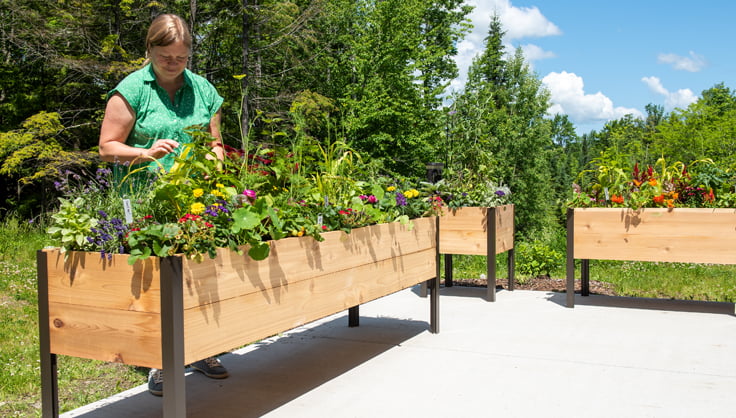
What is a Sensory Garden?
A sensory garden is a garden space designed to stimulate and appeal to one or more of the 5 senses: sight, sound, touch, scent, and taste. All gardens entice the senses in some way, but this type of garden is specifically with visitor engagement in mind
Benefits of Sensory Gardens
Sensory gardens can be therapeutic spaces for healing. They can be serene spots for meditation, yoga, or garden bathing. When used in forms of horticultural therapy, sensory gardens have been shown to enhance workplace wellbeing, be beneficial to those with dementia, and improve learning and focus for children with autism. Sensory gardens can also be educational experiences for children and adults alike to learn about horticulture and ecology.
How to Design a Sensory Garden
The beauty of a sensory garden is that it can be scaled to meet any space, from large-scale landscape installations to container-sized patio or balcony gardens. No available outdoor space? Create an indoor sensory garden with herbs and houseplants.
Here are few general guidelines to get your sensory garden going:
- Elevated raised beds and planters bring the garden up to waist level (or for small children, eye level), making it easier for all to see and access.
- If you have spaces in the garden that require a long walk across rough terrain, consider adding pathways to make the journey smoother.
- Think comfort! Benches and other types of seating encourage visitors to stop, rest, and enjoy the sensory garden experience.
- Designing a garden specifically with young children in mind? Include little nooks for play in between plantings — think a sand box for digging, logs for climbing, or a shallow water table for splashing. Being engaged “in” the garden is much more fun than just observing it from a distance.
Sight
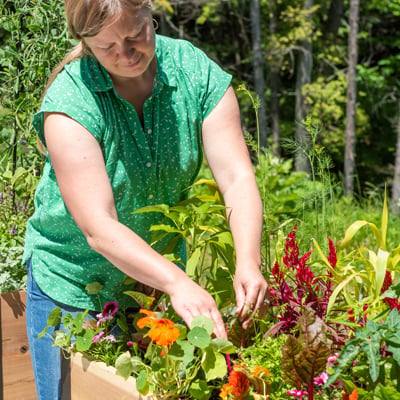 Colors can set the mood. Here, the bright primary hues of celosia, nasturtium, amaranth, and rainbow chard bring cheery, upbeat energy to the garden.
Colors can set the mood. Here, the bright primary hues of celosia, nasturtium, amaranth, and rainbow chard bring cheery, upbeat energy to the garden.When first walking into a plant nursery or greenhouse, most of us likely gravitate towards the plant that “looks the best” without even thinking about it. For a sensory garden, choose a broad variety of plants that bloom at different times of the year. And don’t limit yourself solely to flowers! Foliage, bark, berries, and seedpods bring tons of year-round visual and textural interest.
What kind of mood would you like to evoke? Punchy neon and primary hues like reds, oranges, and yellows, bring cheery, upbeat energy. Want your garden to be a tranquil place of peace? Greens, blues, and pale purples create a calming experience.
Sound
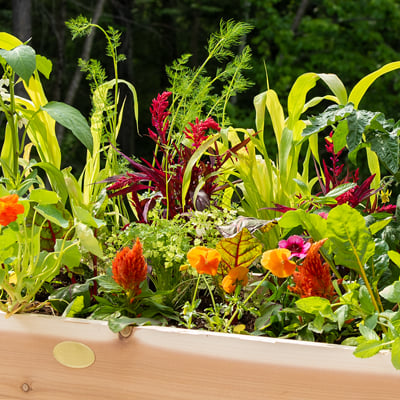 Grasses, like this ornamental millet, create movement and a gentle rustling sound in a breeze.
Grasses, like this ornamental millet, create movement and a gentle rustling sound in a breeze.We may not think of plants as “noisy” but pause and listen next time you are out in the garden; you’ll hear nature interacting with your plants in plenty of ways. A breeze rustles grasses and rattles seedpods. Rain patters on tree leaves. Insects hum between plants and squirrels chatter from branches.
You can help amplify natural sounds in your sensory garden: encourage wildlife to pass through your garden by planting a diversity of native plants and setting up a birdbath or feeder. Wind chimes and water features are also soothing additions to the garden.
Touch
 Choose plants that bring unique textures, like this soft, silky-leaved Artemesia.
Choose plants that bring unique textures, like this soft, silky-leaved Artemesia.Gardening is tactile, and a sensory garden is meant to be handled. Choose plants that can cope. This is not a place to showcase your delicate and rare specimen plants; garden visitors should feel at ease picking and poking all plant parts. Include fuzzy leaves, silky flowers, smooth seedpods, and squishy fruits. Inorganic materials like sand, stone, metal, and brick also bring interesting textures — add these materials to the garden via hardscapes like fountains, benches, and walls.
One point to consider? You may want to steer clear of breakables, like glass, and sharp plants like cacti, thistles, and roses.
Scent
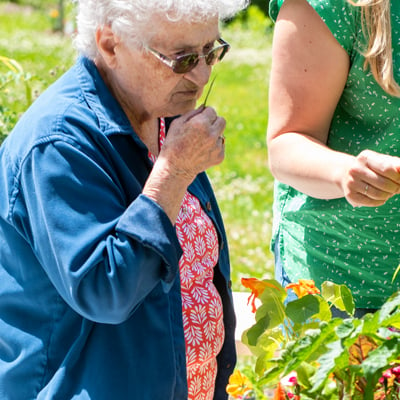 Herbs, like this dill, are both deliciously scented AND flavorful — they make excellent additions to the sensory garden.
Herbs, like this dill, are both deliciously scented AND flavorful — they make excellent additions to the sensory garden.We know now that scent and memory are inextricably linked — furthermore, studies have shown that scents associated with positive memories can help lower stress. Garden scents can range from earthy (fresh mulch, wet leaves) to savory (thyme, tomato) to floral (sweet pea, heliotrope) to fresh (mint, geranium). Some plants like lilac and honeysuckle release their aroma into the air continuously when in bloom. Other plants are more conspicuous and require you to pinch leaves to get a hint of scent; this also encourages visitors to touch and interact with plants. Herbs pack a one-two punch of being both deliciously scented AND flavorful; they make excellent additions to sensory gardens, both indoors and out.
Taste
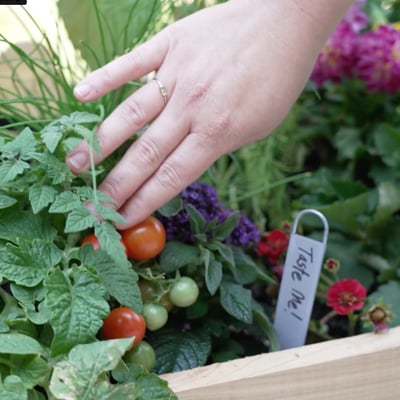 Plant a few things that can be snacked on right in the garden, like cherry tomatoes or strawberries.
Plant a few things that can be snacked on right in the garden, like cherry tomatoes or strawberries.This one is a no-brainer. Plant a few things that can be consumed right off the plant with minimal prep — think tomatoes, strawberries, blueberries, or snap peas. If you have the space, fruit trees, including apple, plum, orange, and pear, make beautiful additions to the sensory garden. Designing a garden for the patio or balcony? Compact varieties of traditionally sprawling veggies, like cucumbers, and even trees, like citrus, can be grown easily in containers. Above all, plant what you love to eat.
Best Plants to Add to Your Sensory Garden
Bonus points for plants that appeal to more than one sense!
| Suggested Plants | What They Bring to the Sensory Garden | Senses |
|---|---|---|
| Agastache spp. | Bright colors and highly aromatic leaves | Sight, Scent |
| Artemisia spp. | Soft silvery foliage plant | Touch |
| Baptisia spp. | Colorful spires of pea-shaped flowers become rattles when seedpods dry | Sight, Sound |
| Basil | Fragrant and flavorful herb | Scent, Taste |
| Bell Pepper | Flavorful fruits in green, red, orange, and yellow | Sight, Taste |
| Celosia | Fuzzy, uniquely shaped flowers in bright colors | Sight, Touch |
| Tomato | Delicious fruits in a variety of colors and sizes | Sight, Scent, Taste |
| Chives | Edible plant with globe-shaped purple flowers | Scent, Taste |
| Dill | Feathery herb with a savory flavor and airy yellow flowers | Sight, Scent, Taste |
| Echevaria | Rosette-shaped succulents with fleshy leaves in green, pink, or gray | Sight, Touch |
| Heliotrope | Sweetly fragrant purple flowers | Sight, Scent |
| Lamb's ears | Velvety soft, silvery foliage | Sight, Touch |
| Lavender | Extremely fragrant silvery foliage and purple flowers | Sight, Scent |
| Lemon Verbena | Aromatic lemon-flavored herb | Scent, Taste |
| Licorice Plant | Soft silvery white foliage | Touch |
| Marigold | Feathery, aromatic foliage topped with vibrant gold and orange ruffled flowers | Sight, Touch, Scent |
| Mint | Freshly scented edible herb | Scent, Taste |
| Nasturtium | Edible flowers in shades of orange, yellow, and red | Sight, Taste |
| Nicotiana | Star-shaped, sweetly scented blooms | Sight, Scent |
| Millet | Tall ornamental grass in shades of yellow to purple | Sight, Sound |
| Sedum | Smooth fleshy leaves | Touch |
| Strawflower | Papery flowers in a range of pastel and neon colors | Sight, Sound |
| Teddy Bear Sunflower | Fuzzy, brightly colored flowers | Sight, Touch |
Last updated: 12/20/2023
Print this Article:
Get the Dirt
Stay up to date on new articles and advice. Please fill out the information below.

